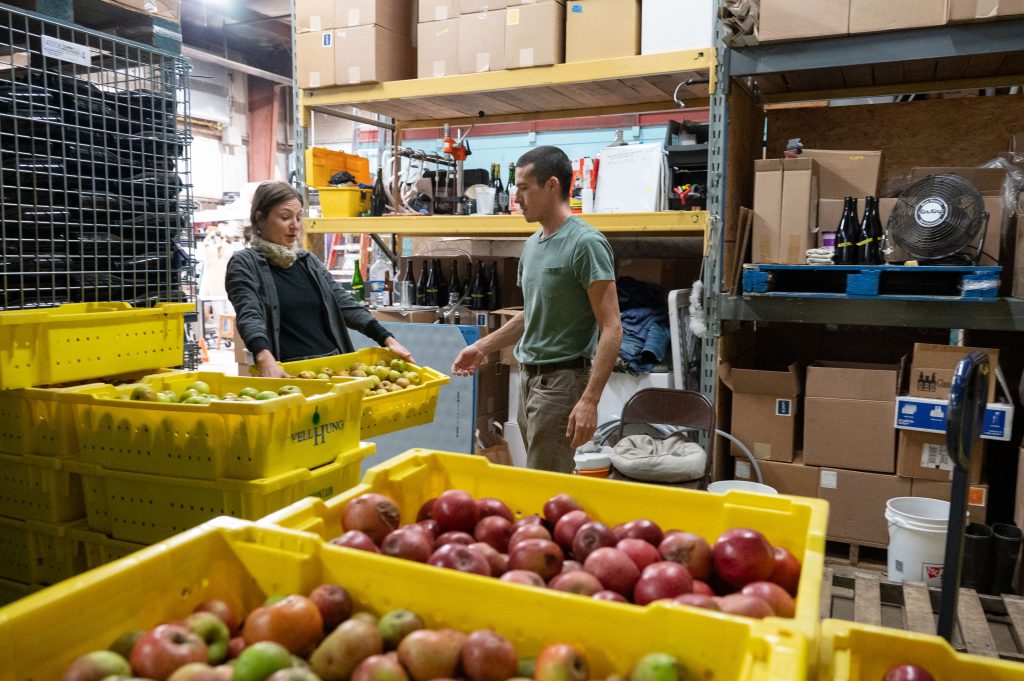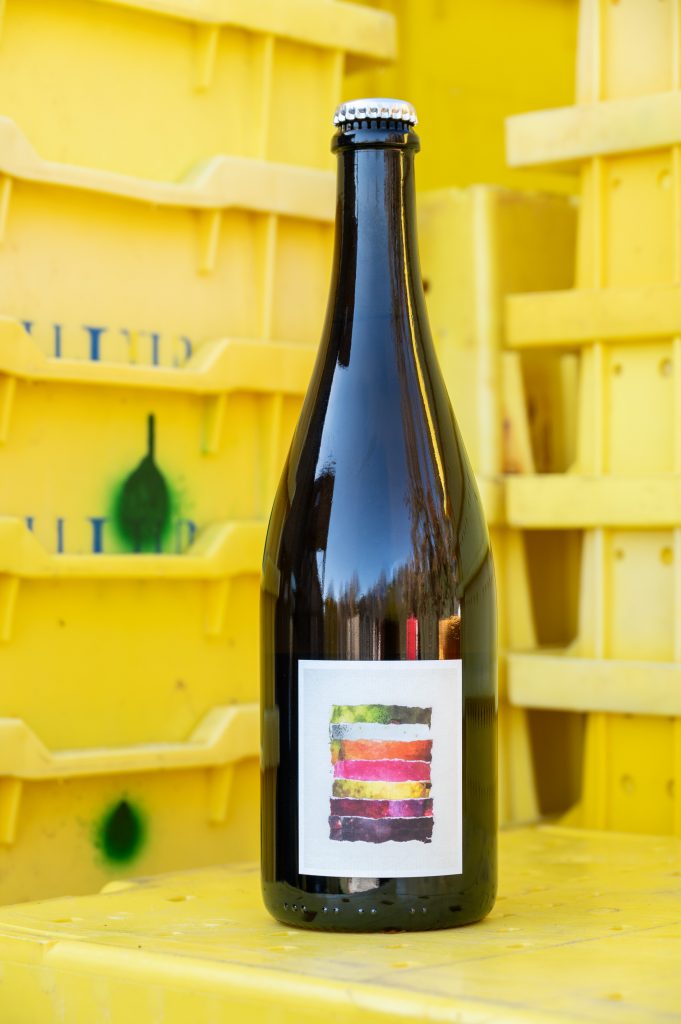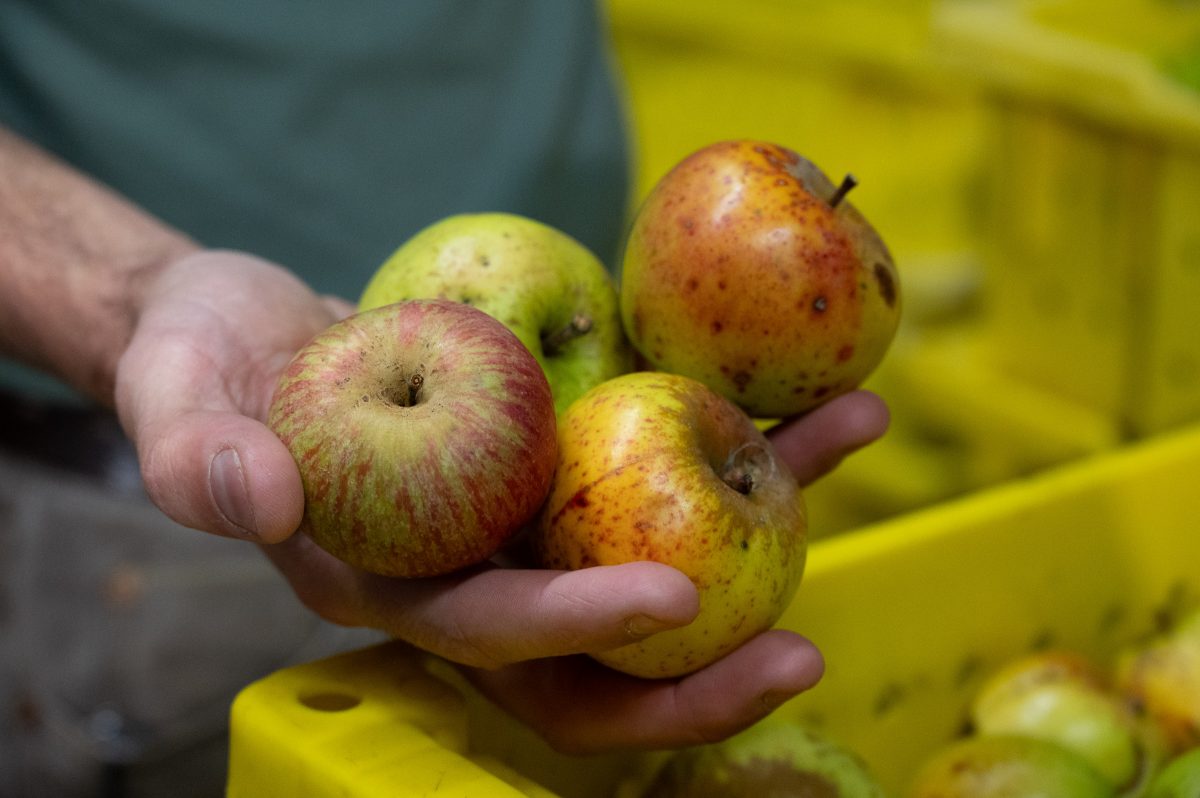October is the tail end of the harvest for Patrick Collins, the cidermaker behind Patois Cider. But the apples on one of his favorite trees are just about ripe.
“That guy there, with all the yellow orbs,” Collins says. “That tree is so delicious. See how it’s still full of leaves? It tastes fantastic, but the fact that it hasn’t defoliated means that it has a super strong immune system.”
Collins has driven his pickup truck to the top of a mountain pass in the Blue Ridge. There are other apple trees scattered in the area, but their branches are bare. This one, Collins notes, impressed and enthusiastic, still has dark-green leaves.
It’s been a dry summer, and drought stress can make trees let go of their leaves early. Even more challenging are the many pests and diseases that plague apple trees. There’s fire blight, cedar apple rust, blossom end rot, apple scab. They are such a problem that the general consensus among orchardists is, you simply can’t grow organic apples in Virginia. But these trees, left to grow untended for 100 years, are doing just fine.

None of the apples here have names. Despite the saying “the apple doesn’t fall far from the tree,” apples grown from seed famously have different characteristics than their parent trees. All of these have grown from scattered seeds. Collins speculates that the trees are descended from a former plantation nearby.
“Almost everybody back then, no matter if it was like a substantial landholder or just a homesteader, one of the first things they would plant would be apple trees,” Collins says. Apples have tremendous variety when grown from seed. “That would allow you to have a variety of different types of crop from the apple trees. Then you’d have fruit that was suitable for drying, fruit that would keep through the winter in your root cellar, and, of course, apples that were suitable for cider, or brandy.”
Now, they’re feral. Which is exactly what Collins is looking for. They’re the opposite of the giant, sugary apples prized in grocery stores.
“These apples are intense,” Collins says. “They’re small, they’re gnarled, the skins are thick, the flesh is substantial, and when you bite into it, you can get popped in the mouth. It’s also about the aromatics. Retro-nasally there’s all these leachy, rose-petal, or sometimes it can be really mossy.”
The things that have been bred out of commercial apples are exactly what Collins wants for cider. Tannins, which are bitter and astringent compounds, give the cider structure and body. High acid content helps control fermentation and adds an enticing flavor.
Collins and his partner, Danielle LeCompte, met while working in the beverage industry, thanks to their passion for cider and wine. They bonded over humble meals and bottles of wine.
“Working in restaurants kind of opened my world to wine,” LeCompte recalls. “There’s something special about a table ordering a bottle of wine instead of everyone getting a separate thing. There was this immediate sense of unity, of a shared experience.”

Two years after meeting, the couple decided to launch a cider business. Collins read books on cidermaking while LeCompte held down a job as a wine distributor. At the time, foraging apples was a necessity. The pair had little more than their passion to work with.
“We started off with a couple thousand dollars in shared savings,” Collins says. “Enough money, essentially, to buy a press, some used barrels, and pay rent.”
Wild apples are a resource that is already out there, if you are willing to get them.
“Going on walks, we noticed an abundance of apples, the apple trees that are wild, on mountainside hikes and mountainside vistas,” LeCompte says. “And Patrick was super keyed in to just being able to look at topographical maps, finding out where some of these orchards are.”
Luck played a part too.
“In 2019, when we did our first fruit foraging run, there was a bounty of fruit,” LeCompte recalls. “Then 2020 followed and there was a late frost, so there was no fruit. If we had started the project in 2020, that would have been extremely discouraging.”
Slowly, Collins and LeCompte learned where to hunt for Virginia’s lost orchards.
“Most of them are around 950 feet on the eastern slopes of the Blue Ridge, because that’s the frost line,” Collins says. “Everything above that, unless it’s on a really well-draining slope, will get frosted. If you see a road that goes to about that elevation and stops on the eastern slopes of the Blue Ridge, there’s hopefully some trees there.”
Seedlings are better adapted to the climate, Collins says, and can be found by going up in elevation in an area where there have been apple trees.
“There’s probably a pretty good chance you’ll see at least one or two,” Collins says.
The pair found themselves retracing Virginia’s faded apple history.

“Apples and peaches were a huge cash crop,” Collins says. “If you look at where the railroad goes, it sort of follows along where these old orchards were because it was exported across the Atlantic and to the West Coast.”
Some of those heirloom varieties, such as Winesaps and Albemarle Pippins, have lasted in abandoned orchards, and Collins and LeCompte still salvage them for cider.
“Albemarle Pippins were the export apple in the 19th century for Virginia,” Collins says. “It’s a keeper and it tastes like a pineapple dessert, but it has the complexity of flavor that you can make cider from it.”
For Collins and LeCompte, necessity overlapped with preference and, more importantly, values. The couple knew they wanted to make organic cider from unsprayed fruit, something that more acutely comes from the earth, rather than what a commercial orchard could supply.
Wild apples are organic as a matter of course, but they’re also uniquely sustainable. Because the trees are still entwined with the environment, they continue to adapt to it.
“Long term, it provides genetic renewal and suitability to the climate,” Collins says. “Genetic variability is not just about disease resistance, it’s also flavor. The apple has some amazing genetic variability and there’s so much potential for complexity of the flavors.”
That reward complements Patois’ forager spirit and the flavor of its cider. There is a sense of discovery, of finding out what nature has decided to make, adapting to it, and using it to its full potential.
Collins is the first to admit that he can romanticize cidermaking, but he enjoys the idea that someone is tasting the mountains and the year and how those regional forces have come together to form these apples year after year.
He contrasts that enjoyment to the enjoyment of commercial wine and its position as an aristocratic symbol.
“What are we celebrating when we celebrate wine?” Collins says, reflecting on the emphasis that is placed on styles made from a particular region or a particular grape variety. “There’s a lot that’s beautiful right here. We’re really motivated to make wine from the commons and celebrate nature as it exists. It’s not being formed or shaped or forced.”

Collins says he would like to have an orchard of his own someday. Tending the trees year after year strikes him as a special and affectionate relationship. But even then, he says, he wouldn’t give up foraging.
“We’ll keep foraging for as long as our bodies allow,” Collins says. “I think there’s something very unique and special to the chance element of foraging. The fact that these just popped up. There’s something very special about them.”
Today’s apples from Jarman’s Gap will go into a particularly interesting cider from Patois, the Bricolage. Bricolage comes from French and denotes something that is built from the parts that are available. Patois Bricolage is just that—a mixture of the apples in abandoned orchards and feral woods crafted into the year’s unique taste.
“Whatever we have on hand, we try to make something beautiful out of it,” Collins says.
Other pressings available are bottled from just one area, one abandoned orchard, or one variety of apple. Albemarle Pippin is a heritage variety that Collins enjoys bottling on its own as an homage to the industry.
Most of their products go wholesale to small, craft wineshops as far away as New York, Chicago, and New Orleans. Locally, they can be found at Greenwood Grocery, Market Street Wine, and Wine Warehouse. For those who want to meet the makers, bottles are also available directly from Patois via its website.
